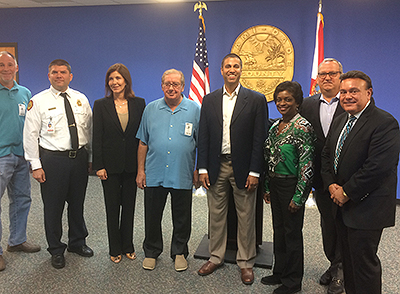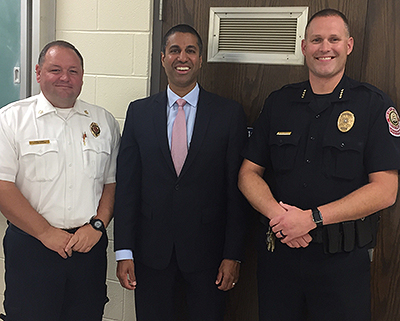September 2017 will long be remembered for devastating storms. Hurricanes Harvey, Irma, and Maria each caused billions of dollars in damage, claimed the lives of many Americans, and disrupted millions more. They also reminded us how important communications networks can be during emergencies—and that the FCC has a role to play in helping keep people safe.
I recently had the chance to see these factors at play firsthand. I traveled to South Florida with Commissioner Mignon Clyburn to survey the impact of Hurricane Irma. I then flew directly to Indiana, where I resumed my ongoing tour of U.S. communities impacted by the digital divide. Fittingly, this leg of the tour focused on public safety and emergency communications.
As always, getting out of Washington to learn about how Americans are dealing with communications challenges in their communities offered many valuable lessons.
While in Florida, Commissioner Clyburn and I met with first responders at the Miami Dade Emergency Operations Center. Not surprisingly, the call volume at the Center went up dramatically during the storm—an estimated three times the normal volume of calls. Spikes like this place tremendous strain on the system and make it harder for incoming calls to get through. At the same time, there were major power outages, which impacted landline phone service and home Internet connectivity. These developments appear to have had ripple effects.

Chairman Pai and Commissioner Clyburn with first responders at the Miami Dade Emergency Operations Center.
One is that people turned to radio as a reliable source of information—both over-the-air and on their phones via apps. In the Miami area, we heard from WIOD 610 AM's Jimmy Cefalo (yes, that one) and Tu 94.9's Enrique Santos how folks tuned in with a desperate desire for information—a feeling matched by the hosts' dedication to serving their community. And traffic on the NextRadio app went up 800% during the storm.
Another consequence of a congested 911 system is that the public is increasingly turning to social media to seek help and to get information. According to local authorities, this trend is a double-edged sword. Social media holds tremendous potential to empower citizens and fill in gaps when other options fail or are otherwise unavailable. But it also raises concerns for first responders. For one thing, public safety authorities generally do not actively monitor social media feeds as a matter of standard operating procedure. But the more daunting problem for first responders is how to collect, verify, integrate, and translate incoming social media requests to enable a suitable response. Moving forward, 911 is still the best way to seek and obtain emergency assistance. More study is needed on how best to use social media as another tool for first responders without hampering ongoing efforts to improve location accuracy and promote Next Generation 911 (NG911).
First responders on the ground in Florida also raised concerns about the need for better coordination between power companies and telecommunications companies concerning relief and restoration efforts. That's essential because power is vital to networks getting and staying up and devices remaining useful to consumers. These are just some of the issues raised by the recent hurricanes that the FCC and all stakeholders need to examine as we move forward.
From Florida, I went on to visit 911 call centers in Noblesville, Indiana with Congresswoman Susan Brooks; Harrisburg, Illinois with Congressman John Shimkus; Joplin, Missouri; and Wichita, Kansas with Congressman Ron Estes. These visits highlighted a different set of opportunities and challenges.
One encouraging thing I saw was inter-jurisdictional collaboration. It can be expensive and difficult for a single town or county to maintain a 911 system. Upgrading a system to Next Generation 911—essentially an Internet Protocol-based 911 system—is too often impossible for a smaller, cash-strapped jurisdiction. But there's strength in numbers, as some counties in Illinois and Kansas have found by banding together.
In southern Illinois, for example, over a dozen rural counties have come together to leverage their resources. Because of that, they're able to deliver first-rate public safety service through a regional Emergency Services Internet-Protocol Network, or ESInet. Because of their scale, they've been able to drive better deals in the deployment of fiber and other IP-based infrastructure. And because the system is so supple, instead of having multiple short-staffed call centers, dispatchers on one end of the state can handle calls from a county on the other end of the state, and vice versa. This consortium has also upgraded its systems to receive text-to-911 communications. (For a more in-depth discussion on why ESInets provide more resilient, redundant communications services and are important in the transition to NG911, see this article.)
Kansas has seen similar benefits of coordination, but with a different model. The Sunflower State has established a state-wide 911 Coordinating Council
that shares baseline, uniform standards for collecting and sharing things like mapping data and other information to all 911 call centers. As a result, call takers in Sedgwick County, which is home to Wichita (Kansas' largest city), have the same data at their disposal as call takers in remote Greeley County (population 1,300).
While I left each of these visits heartened by the state of our emergency response systems, there's no question that our first responders face significant challenges.
One constant refrain was the huge number of misdialed 911 calls. Pocket dials might seem funny, but at one call center, misdials account for almost one-fifth of all incoming calls. When you consider that dispatchers have to stay on the line during all calls and are then required to call back a disconnected call, this is a very real drain on resources.
Another problem was the need for improved location accuracy for mobile 911 calls. A strong majority of 911 calls in most places I visited are placed on mobile phones, and call takers sometimes struggle to pinpoint exactly where the caller is.
Yet another issue is staffing attrition. Being a call-taker or dispatcher is a hard job. Your shift is between one-third and half a day, and in that time you never know how many calls you'll get or what they might involve—a heart attack, a woman giving birth, or something else. In Noblesville, Indiana, it's so hard to attract and retain dispatchers that they've had to extend shifts from 8 hours to 12 hours—to stretch human resources as far as they can.
As mentioned above, Next Generation 911 offers great potential for the future of public safety. But too many jurisdictions are struggling with how to transition from their legacy systems to NG911. There are significant costs involved, not to mention other issues, like the need for enhanced training of 911 call takers and ensuring that NG911 deployment is standards-based. All of us need to think creatively about how to address these issues going forward.
* * *
The storms of September have underscored the importance of a robust public safety system. I've seen that for myself in my recent travels. I hope to incorporate lessons from my visits in order to help the FCC better meet Congress' charge to "promot[e] safety of life and property through the use of wire and radio communications."
